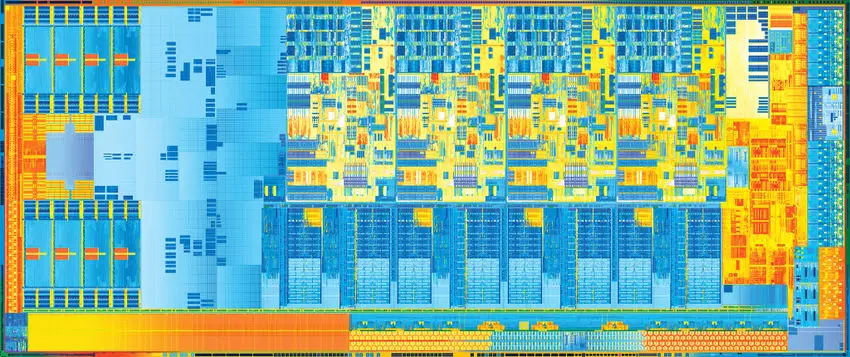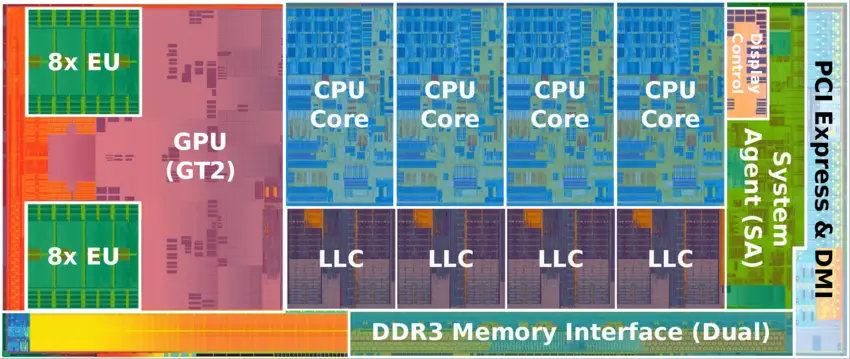From WikiChip
Difference between revisions of "intel/microarchitectures/ivy bridge (client)"
| Line 15: | Line 15: | ||
'''Ivy Bridge''' was [[Intel]]'s [[microarchitecture]] based on the [[22 nm process]] for desktops and servers. Ivy Bridge was introduced in 2011 as a [[process shrink]] of {{\\|Sandy Bridge}} which introduced a number enhancements. Ivy Bridge became Intel's first microarchitecture to use [[tri-gate transistor]]s for their commercial products. | '''Ivy Bridge''' was [[Intel]]'s [[microarchitecture]] based on the [[22 nm process]] for desktops and servers. Ivy Bridge was introduced in 2011 as a [[process shrink]] of {{\\|Sandy Bridge}} which introduced a number enhancements. Ivy Bridge became Intel's first microarchitecture to use [[tri-gate transistor]]s for their commercial products. | ||
| − | For desktop and mobile, Ivy Bridge is branded as | + | For desktop and mobile, Ivy Bridge is branded as 3rd Generation Intel {{intel|Core}} processors. For server class processors, Intel branded it as {{intel|Xeon E3|Xeon E3 v2}}, {{intel|Xeon E5|Xeon E5 v2}}, and {{intel|Xeon E7|Xeon E7 v2}}. |
== Codenames == | == Codenames == | ||
{{empty section}} | {{empty section}} | ||
Revision as of 19:15, 1 May 2016
| Edit Values | |
| Ivy Bridge µarch | |
| General Info |
Ivy Bridge was Intel's microarchitecture based on the 22 nm process for desktops and servers. Ivy Bridge was introduced in 2011 as a process shrink of Sandy Bridge which introduced a number enhancements. Ivy Bridge became Intel's first microarchitecture to use tri-gate transistors for their commercial products.
For desktop and mobile, Ivy Bridge is branded as 3rd Generation Intel Core processors. For server class processors, Intel branded it as Xeon E3 v2, Xeon E5 v2, and Xeon E7 v2.
Codenames
| This section is empty; you can help add the missing info by editing this page. |
Architecture
| This section is empty; you can help add the missing info by editing this page. |
Die
Quad-core Ivy Bridge die:
- 1,480,000,000 transistors
- 160 mm2
- 4 CPU cores
- 1 GPU core
- 2x8xEU (64 ALUs)
- 22 nm process
Cores
| This section is empty; you can help add the missing info by editing this page. |
All Ivy Bridge Chips
| Ivy Bridge Chips | |||||||||||
|---|---|---|---|---|---|---|---|---|---|---|---|
| Main processor | IGP | ||||||||||
| Model | µarch | Platform | Core | Launched | SDP | TDP | Freq | Max Mem | Name | Freq | Max Freq |
| 1007U | Ivy Bridge | Ivy Bridge | 20 January 2013 | 17 W 17,000 mW 0.0228 hp 0.017 kW | 1,500 MHz 1.5 GHz 1,500,000 kHz | 32,768 MiB 33,554,432 KiB 34,359,738,368 B 32 GiB 0.0313 TiB | Intel HD Graphics | 350 MHz 0.35 GHz 350,000 KHz | 1,000 MHz 1 GHz 1,000,000 KHz | ||
| i7-3770K | Ivy Bridge | Ivy Bridge-HE-4 | 23 April 2012 | 77 W 77,000 mW 0.103 hp 0.077 kW | 3,500 MHz 3.5 GHz 3,500,000 kHz | 32,768 MiB 33,554,432 KiB 34,359,738,368 B 32 GiB 0.0313 TiB | Intel HD Graphics 4000 | 650 MHz 0.65 GHz 650,000 KHz | 1,150 MHz 1.15 GHz 1,150,000 KHz | ||
| i7-3920XM | Ivy Bridge | Panther Point | Ivy Bridge | 28 April 2012 | 55 W 55,000 mW 0.0738 hp 0.055 kW | 2,900 MHz 2.9 GHz 2,900,000 kHz | 32,768 MiB 33,554,432 KiB 34,359,738,368 B 32 GiB 0.0313 TiB | Intel HD Graphics 4000 | 650 MHz 0.65 GHz 650,000 KHz | 1,300 MHz 1.3 GHz 1,300,000 KHz | |
| i7-3940XM | Ivy Bridge | Panther Point | Ivy Bridge | 30 September 2012 | 55 W 55,000 mW 0.0738 hp 0.055 kW | 3,000 MHz 3 GHz 3,000,000 kHz | 32,768 MiB 33,554,432 KiB 34,359,738,368 B 32 GiB 0.0313 TiB | Intel HD Graphics 4000 | 650 MHz 0.65 GHz 650,000 KHz | 1,350 MHz 1.35 GHz 1,350,000 KHz | |
| i7-4960X | Ivy Bridge | X79 | Ivy Bridge E | 10 September 2013 | 130 W 130,000 mW 0.174 hp 0.13 kW | 3,600 MHz 3.6 GHz 3,600,000 kHz | 65,536 MiB 67,108,864 KiB 68,719,476,736 B 64 GiB 0.0625 TiB | ||||

